compressor check SUZUKI SWIFT 2005 2.G Service Owner's Guide
[x] Cancel search | Manufacturer: SUZUKI, Model Year: 2005, Model line: SWIFT, Model: SUZUKI SWIFT 2005 2.GPages: 1496, PDF Size: 34.44 MB
Page 972 of 1496
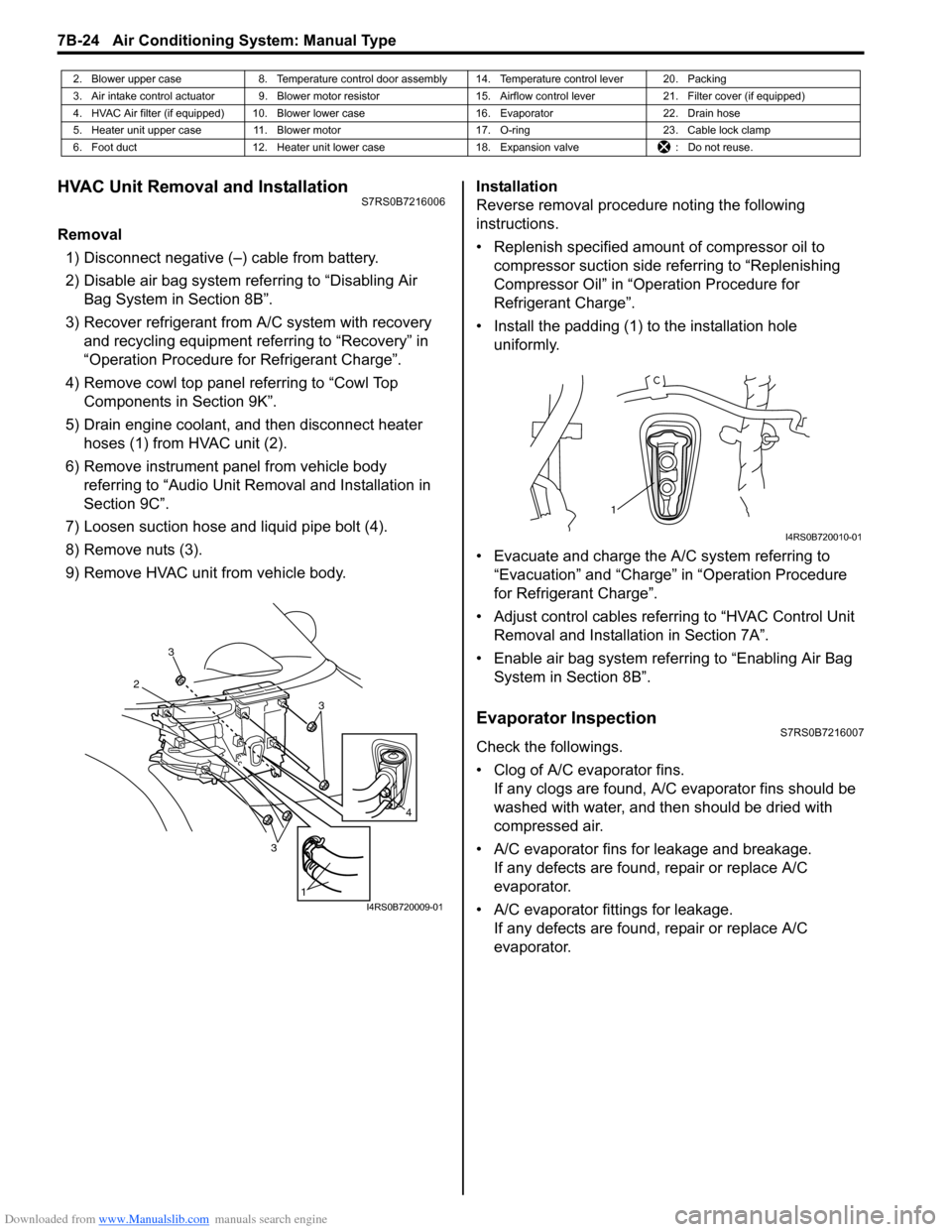
Downloaded from www.Manualslib.com manuals search engine 7B-24 Air Conditioning System: Manual Type
HVAC Unit Removal and InstallationS7RS0B7216006
Removal1) Disconnect negative (тАУ) cable from battery.
2) Disable air bag system referring to тАЬDisabling Air Bag System in Section 8BтАЭ.
3) Recover refrigerant from A/C system with recovery and recycling equipment referring to тАЬRecoveryтАЭ in
тАЬOperation Procedure for Refrigerant ChargeтАЭ.
4) Remove cowl top panel referring to тАЬCowl Top Components in Section 9KтАЭ.
5) Drain engine coolant, and then disconnect heater hoses (1) from HVAC unit (2).
6) Remove instrument panel from vehicle body referring to тАЬAudio Unit Re moval and Installation in
Section 9CтАЭ.
7) Loosen suction hose and liquid pipe bolt (4).
8) Remove nuts (3).
9) Remove HVAC unit from vehicle body. Installation
Reverse removal procedure noting the following
instructions.
тАв Replenish specified amount of compressor oil to
compressor suction side referring to тАЬReplenishing
Compressor OilтАЭ in тАЬOperation Procedure for
Refrigerant ChargeтАЭ.
тАв Install the padding (1) to the installation hole uniformly.
тАв Evacuate and charge the A/C system referring to тАЬEvacuationтАЭ and тАЬChargeтАЭ in тАЬOperation Procedure
for Refrigerant ChargeтАЭ.
тАв Adjust control cables referr ing to тАЬHVAC Control Unit
Removal and Installati on in Section 7AтАЭ.
тАв Enable air bag system referring to тАЬEnabling Air Bag System in Section 8BтАЭ.
Evaporator InspectionS7RS0B7216007
Check the followings.
тАв Clog of A/C evaporator fins.If any clogs are found, A/C evaporator fins should be
washed with water, and then should be dried with
compressed air.
тАв A/C evaporator fins for leakage and breakage. If any defects are found, repair or replace A/C
evaporator.
тАв A/C evaporator fittings for leakage. If any defects are found, repair or replace A/C
evaporator.
2. Blower upper case 8. Temperature control door assembly 14. Temperature control lever 20. Packing
3. Air intake control actuator 9. Blower motor resistor 15. Airflow control lever21. Filter cover (if equipped)
4. HVAC Air filter (if equipped) 10. Blower lower case 16. Evaporator22. Drain hose
5. Heater unit upper case 11. Blower motor 17. O-ring23. Cable lock clamp
6. Foot duct 12. Heater unit lower case 18. Expansion valve: Do not reuse.
3
2
3
3
1
4
I4RS0B720009-01
1
I4RS0B720010-01
Page 974 of 1496
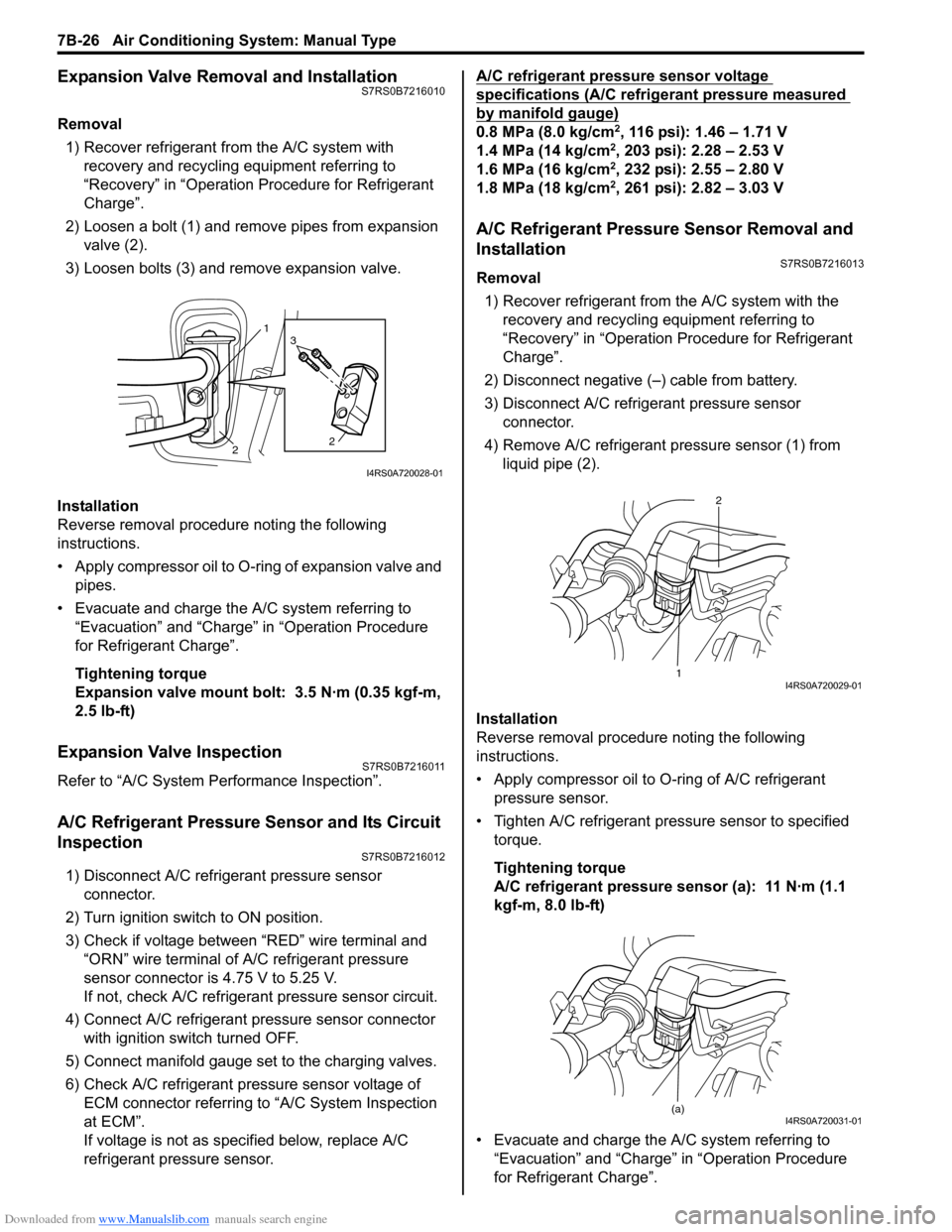
Downloaded from www.Manualslib.com manuals search engine 7B-26 Air Conditioning System: Manual Type
Expansion Valve Removal and InstallationS7RS0B7216010
Removal1) Recover refrigerant fr om the A/C system with
recovery and recycling equipment referring to
тАЬRecoveryтАЭ in тАЬOperation Procedure for Refrigerant
ChargeтАЭ.
2) Loosen a bolt (1) and remove pipes from expansion valve (2).
3) Loosen bolts (3) and remove expansion valve.
Installation
Reverse removal procedure noting the following
instructions.
тАв Apply compressor oil to O-ring of expansion valve and pipes.
тАв Evacuate and charge the A/C system referring to тАЬEvacuationтАЭ and тАЬChargeтАЭ in тАЬOperation Procedure
for Refrigerant ChargeтАЭ.
Tightening torque
Expansion valve mount bolt: 3.5 N┬╖m (0.35 kgf-m,
2.5 lb-ft)
Expansion Valve InspectionS7RS0B7216011
Refer to тАЬA/C System Performance InspectionтАЭ.
A/C Refrigerant Pressure Sensor and Its Circuit
Inspection
S7RS0B7216012
1) Disconnect A/C refrigerant pressure sensor connector.
2) Turn ignition switch to ON position.
3) Check if voltage between тАЬREDтАЭ wire terminal and тАЬORNтАЭ wire terminal of A/C refrigerant pressure
sensor connector is 4.75 V to 5.25 V.
If not, check A/C refrigerant pressure sensor circuit.
4) Connect A/C refrigerant pressure sensor connector with ignition switch turned OFF.
5) Connect manifold gauge set to the charging valves.
6) Check A/C refrigerant pressure sensor voltage of ECM connector referring to тАЬA/C System Inspection
at ECMтАЭ.
If voltage is not as specified below, replace A/C
refrigerant pressure sensor. A/C refrigerant pressure sensor voltage
specifications (A/C refrigerant pressure measured
by manifold gauge)
0.8 MPa (8.0 kg/cm2, 116 psi): 1.46 тАУ 1.71 V
1.4 MPa (14 kg/cm2, 203 psi): 2.28 тАУ 2.53 V
1.6 MPa (16 kg/cm2, 232 psi): 2.55 тАУ 2.80 V
1.8 MPa (18 kg/cm2, 261 psi): 2.82 тАУ 3.03 V
A/C Refrigerant Pressure Sensor Removal and
Installation
S7RS0B7216013
Removal
1) Recover refrigerant from the A/C system with the recovery and recycling equipment referring to
тАЬRecoveryтАЭ in тАЬOperation Procedure for Refrigerant
ChargeтАЭ.
2) Disconnect negative (тАУ) cable from battery.
3) Disconnect A/C refrigerant pressure sensor connector.
4) Remove A/C refrigerant pressure sensor (1) from liquid pipe (2).
Installation
Reverse removal procedure noting the following
instructions.
тАв Apply compressor oil to O-ring of A/C refrigerant
pressure sensor.
тАв Tighten A/C refrigerant pressure sensor to specified torque.
Tightening torque
A/C refrigerant pressure sensor (a): 11 N┬╖m (1.1
kgf-m, 8.0 lb-ft)
тАв Evacuate and charge the A/C system referring to тАЬEvacuationтАЭ and тАЬChargeтАЭ in тАЬOperation Procedure
for Refrigerant ChargeтАЭ.
1
2 2
3
I4RS0A720028-01
1 2I4RS0A720029-01
(a)I4RS0A720031-01
Page 975 of 1496
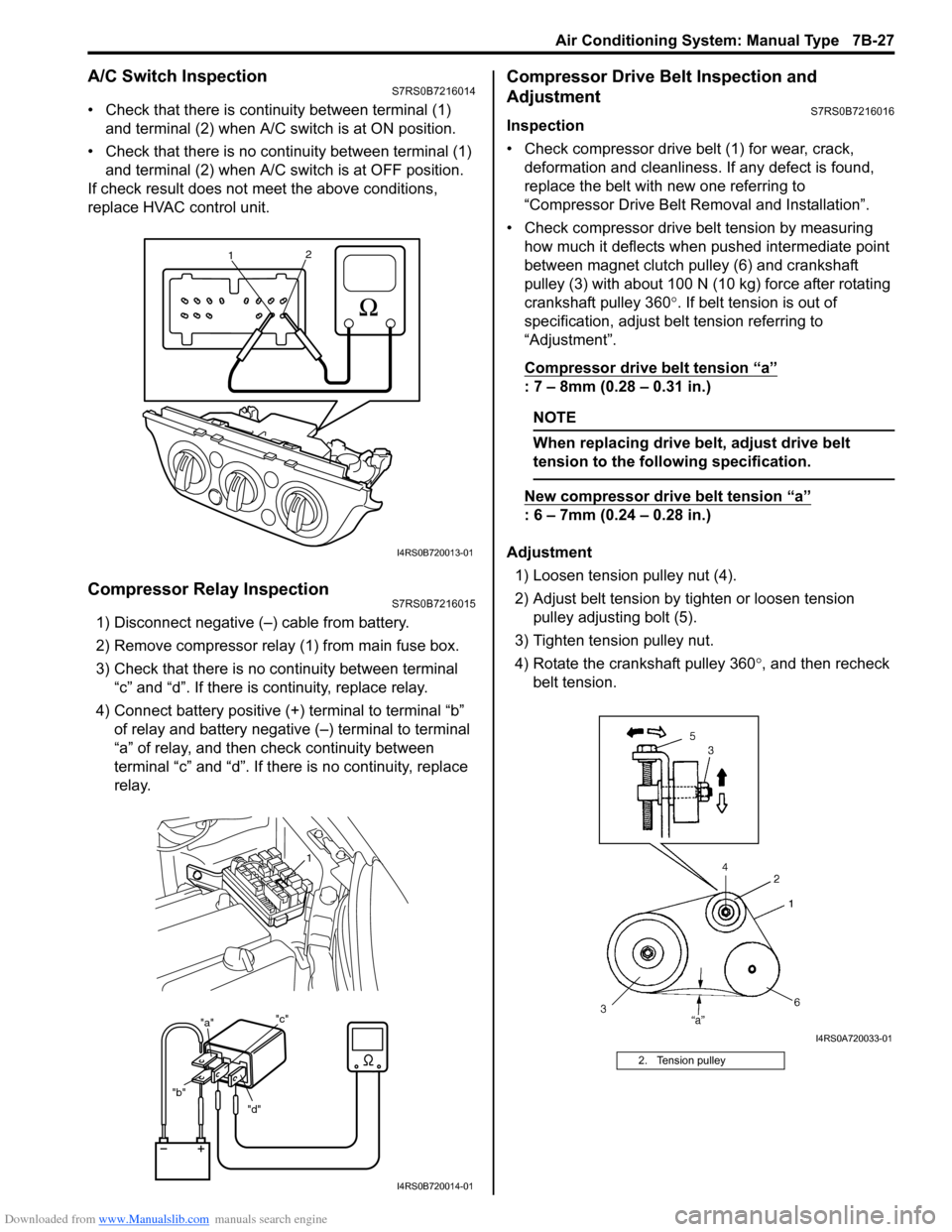
Downloaded from www.Manualslib.com manuals search engine Air Conditioning System: Manual Type 7B-27
A/C Switch InspectionS7RS0B7216014
тАв Check that there is continuity between terminal (1) and terminal (2) when A/C s witch is at ON position.
тАв Check that there is no continuity between terminal (1) and terminal (2) when A/C s witch is at OFF position.
If check result does not meet the above conditions,
replace HVAC control unit.
Compressor Relay InspectionS7RS0B7216015
1) Disconnect negative (тАУ) cable from battery.
2) Remove compressor relay (1) from main fuse box.
3) Check that there is no continuity between terminal тАЬcтАЭ and тАЬdтАЭ. If there is continuity, replace relay.
4) Connect battery positive (+ ) terminal to terminal тАЬbтАЭ
of relay and battery negative (тАУ) terminal to terminal
тАЬaтАЭ of relay, and then check continuity between
terminal тАЬcтАЭ and тАЬdтАЭ. If there is no continuity, replace
relay.
Compressor Drive Belt Inspection and
Adjustment
S7RS0B7216016
Inspection
тАв Check compressor drive belt (1) for wear, crack, deformation and cleanliness. If any defect is found,
replace the belt with new one referring to
тАЬCompressor Drive Belt Re moval and InstallationтАЭ.
тАв Check compressor drive belt tension by measuring how much it deflects when pushed intermediate point
between magnet clutch pulley (6) and crankshaft
pulley (3) with about 100 N (10 kg) force after rotating
crankshaft pulley 360 ┬░. If belt tension is out of
specification, adjust belt tension referring to
тАЬAdjustmentтАЭ.
Compressor drive belt tension
тАЬaтАЭ
: 7 тАУ 8mm (0.28 тАУ 0.31 in.)
NOTE
When replacing drive belt, adjust drive belt
tension to the following specification.
New compressor dr ive belt tension тАЬaтАЭ
: 6 тАУ 7mm (0.24 тАУ 0.28 in.)
Adjustment 1) Loosen tension pulley nut (4).
2) Adjust belt tension by ti ghten or loosen tension
pulley adjusting bolt (5).
3) Tighten tension pulley nut.
4) Rotate the crankshaft pulley 360 ┬░, and then recheck
belt tension.
1 2
I4RS0B720013-01
"d"
"b" "a"
"c"
1
I4RS0B720014-01
2. Tension pulley
I4RS0A720033-01
Page 977 of 1496
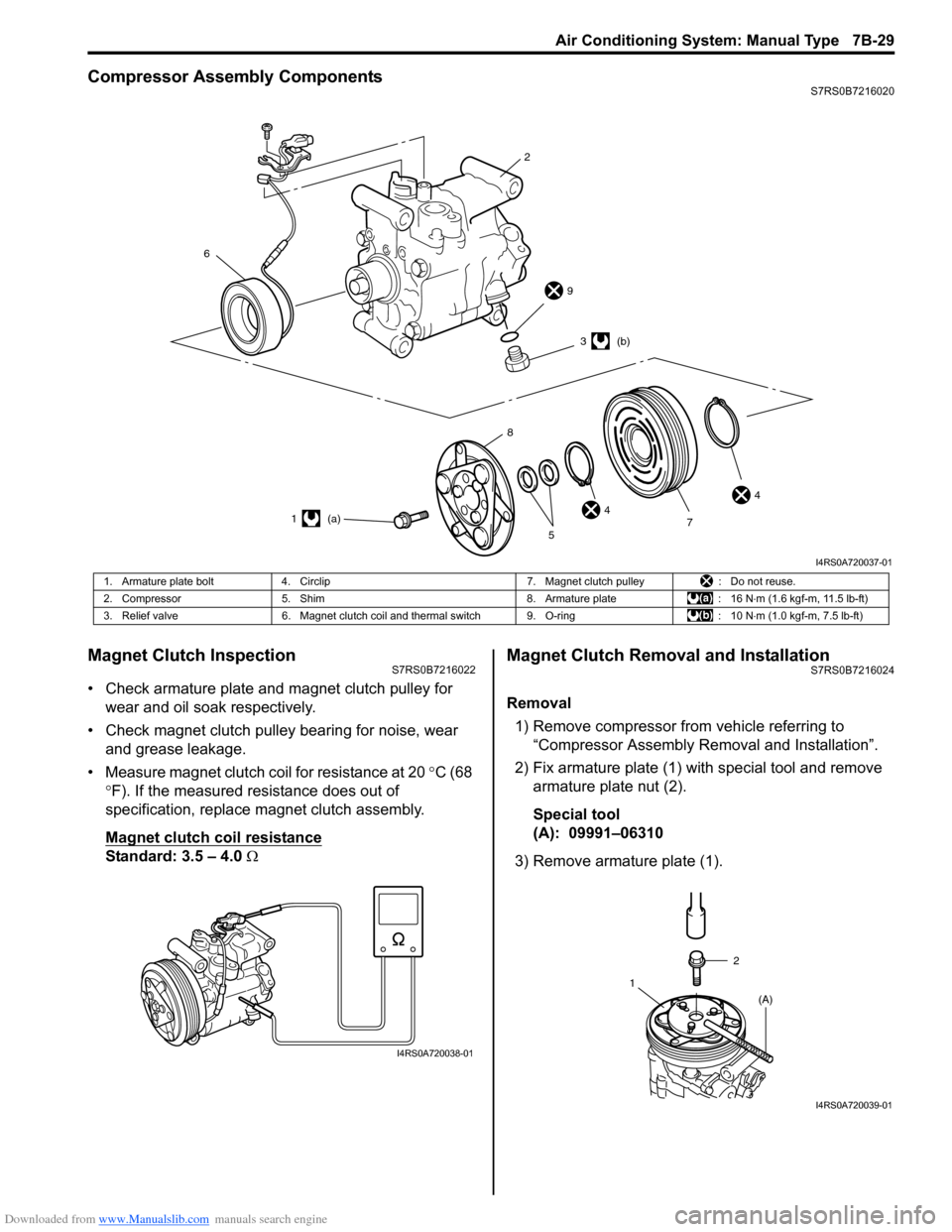
Downloaded from www.Manualslib.com manuals search engine Air Conditioning System: Manual Type 7B-29
Compressor Assembly ComponentsS7RS0B7216020
Magnet Clutch InspectionS7RS0B7216022
тАв Check armature plate and magnet clutch pulley for wear and oil soak respectively.
тАв Check magnet clutch pulley bearing for noise, wear and grease leakage.
тАв Measure magnet clutch coil for resistance at 20 ┬░C (68
┬░ F). If the measured resistance does out of
specification, replace magnet clutch assembly.
Magnet clutch coil resistance
Standard: 3.5 тАУ 4.0 тДж
Magnet Clutch Removal and InstallationS7RS0B7216024
Removal
1) Remove compressor from vehicle referring to тАЬCompressor Assembly Re moval and InstallationтАЭ.
2) Fix armature plate (1) with special tool and remove armature plate nut (2).
Special tool
(A): 09991тАУ06310
3) Remove armature plate (1).
6
2
9
44
3 (b)
1 (a) 7
5
8
I4RS0A720037-01
1. Armature plate bolt
4. Circlip 7. Magnet clutch pulley: Do not reuse.
2. Compressor 5. Shim 8. Armature plate: 16 NтЛЕm (1.6 kgf-m, 11.5 lb-ft)
3. Relief valve 6. Magnet clutch coil and thermal switch 9. O-ring : 10 NтЛЕm (1.0 kgf-m, 7.5 lb-ft)
I4RS0A720038-01
2
1 (A)
I4RS0A720039-01
Page 987 of 1496
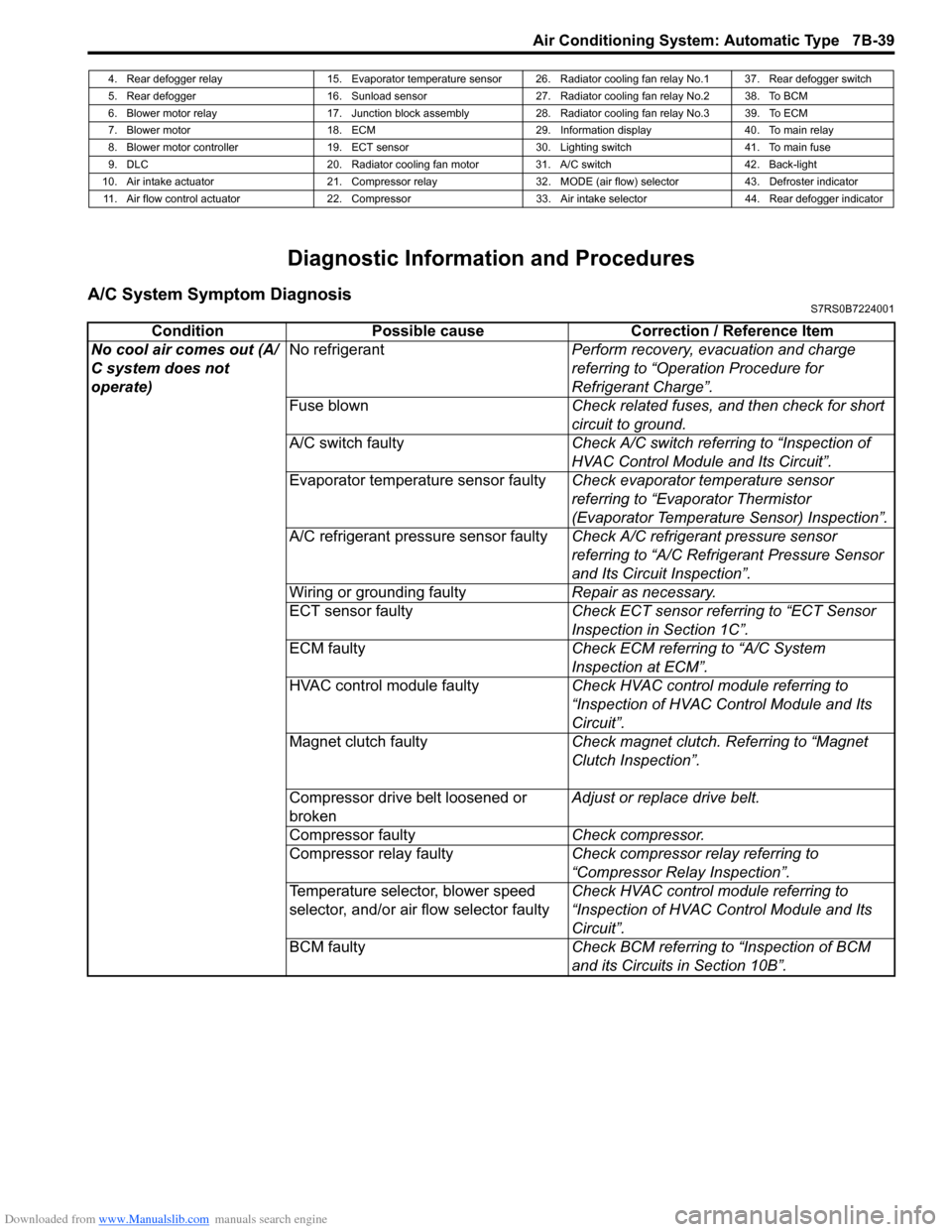
Downloaded from www.Manualslib.com manuals search engine Air Conditioning System: Automatic Type 7B-39
Diagnostic Information and Procedures
A/C System Symptom DiagnosisS7RS0B7224001
4. Rear defogger relay 15. Evaporator temperature sensor 26. Radiator cooling fan relay No.1 37. Rear defogger switch
5. Rear defogger 16. Sunload sensor 27. Radiator cooling fan relay No.2 38. To BCM
6. Blower motor relay 17. Junction block assembly 28. Radiator cooling fan relay No.3 39. To ECM
7. Blower motor 18. ECM 29. Information display 40. To main relay
8. Blower motor controller 19. ECT sensor 30. Lighting switch 41. To main fuse
9. DLC 20. Radiator cooling fan motor 31. A/C switch 42. Back-light
10. Air intake actuator 21. Compressor relay 32. MODE (air flow) selector 43. Defroster indicator 11. Air flow control actuator 22. Compressor 33. Air intake selector 44. Rear defogger indicator
Condition Possible cause Correction / Reference Item
No cool air comes out (A/
C system does not
operate) No refrigerant
Perform recovery, evacuation and charge
referring to тАЬOperation Procedure for
Refrigerant ChargeтАЭ.
Fuse blown Check related fuses, and then check for short
circuit to ground.
A/C switch faulty Check A/C switch referring to тАЬInspection of
HVAC Control Module and Its CircuitтАЭ.
Evaporator temperature sensor faulty Check evaporator temperature sensor
referring to тАЬEvaporator Thermistor
(Evaporator Temperature Sensor) InspectionтАЭ.
A/C refrigerant pressure sensor faulty Check A/C refrigerant pressure sensor
referring to тАЬA/C Refrigerant Pressure Sensor
and Its Circuit InspectionтАЭ.
Wiring or grounding faulty Repair as necessary.
ECT sensor faulty Check ECT sensor referring to тАЬECT Sensor
Inspection in Section 1CтАЭ.
ECM faulty Check ECM referring to тАЬA/C System
Inspection at ECMтАЭ.
HVAC control module faulty Check HVAC control module referring to
тАЬInspection of HVAC Control Module and Its
CircuitтАЭ.
Magnet clutch faulty Check magnet clutch. Referring to тАЬMagnet
Clutch InspectionтАЭ.
Compressor drive belt loosened or
broken Adjust or replace drive belt.
Compressor faulty Check compressor.
Compressor relay faulty Check compressor relay referring to
тАЬCompressor Relay InspectionтАЭ.
Temperature selector, blower speed
selector, and/or air flow selector faulty Check HVAC control module referring to
тАЬInspection of HVAC Control Module and Its
CircuitтАЭ.
BCM faulty Check BCM referring to тАЬInspection of BCM
and its Circuits in Section 10BтАЭ.
Page 989 of 1496
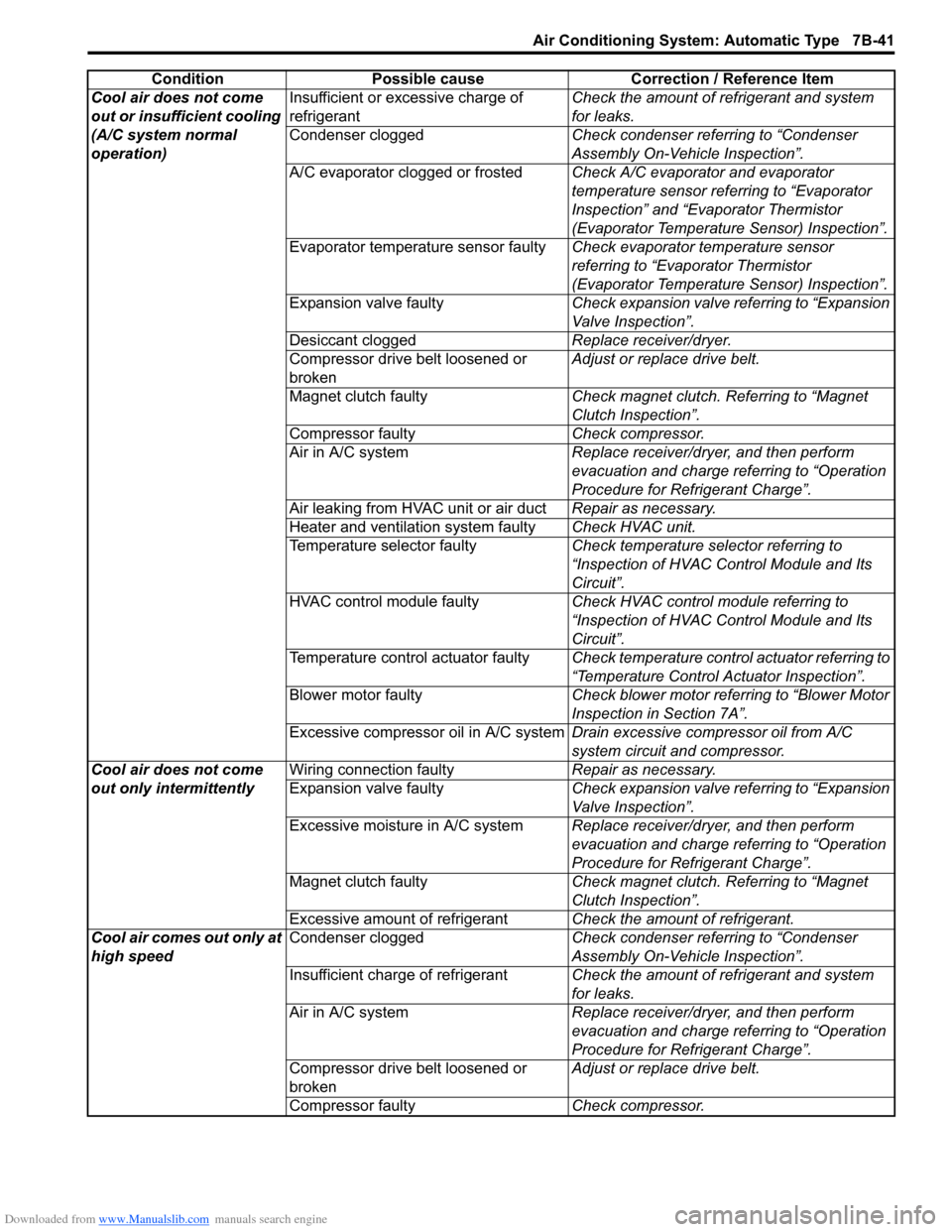
Downloaded from www.Manualslib.com manuals search engine Air Conditioning System: Automatic Type 7B-41
Cool air does not come
out or insufficient cooling
(A/C system normal
operation)Insufficient or excessive charge of
refrigerant
Check the amount of refrigerant and system
for leaks.
Condenser clogged Check condenser referring to тАЬCondenser
Assembly On-Vehicle InspectionтАЭ.
A/C evaporator clogged or frosted Check A/C evaporator and evaporator
temperature sensor referring to тАЬEvaporator
InspectionтАЭ and тАЬEvaporator Thermistor
(Evaporator Temperature Sensor) InspectionтАЭ.
Evaporator temperature sensor faulty Check evaporator temperature sensor
referring to тАЬEvaporator Thermistor
(Evaporator Temperature Sensor) InspectionтАЭ.
Expansion valve faulty Check expansion valve referring to тАЬExpansion
Valve InspectionтАЭ.
Desiccant clogged Replace receiver/dryer.
Compressor drive belt loosened or
broken Adjust or replace drive belt.
Magnet clutch faulty Check magnet clutch. Referring to тАЬMagnet
Clutch InspectionтАЭ.
Compressor faulty Check compressor.
Air in A/C system Replace receiver/dryer, and then perform
evacuation and charge referring to тАЬOperation
Procedure for Refrigerant ChargeтАЭ.
Air leaking from HVAC unit or air duct Repair as necessary.
Heater and ventilation system faulty Check HVAC unit.
Temperature selector faulty Check temperature selector referring to
тАЬInspection of HVAC Control Module and Its
CircuitтАЭ.
HVAC control module faulty Check HVAC control module referring to
тАЬInspection of HVAC Control Module and Its
CircuitтАЭ.
Temperature control actuator faulty Check temperature control actuator referring to
тАЬTemperature Control Actuator InspectionтАЭ.
Blower motor faulty Check blower motor referring to тАЬBlower Motor
Inspection in Section 7AтАЭ.
Excessive compressor oil in A/C system Drain excessive compressor oil from A/C
system circuit and compressor.
Cool air does not come
out only intermittently Wiring connection faulty
Repair as necessary.
Expansion valve faulty Check expansion valve referring to тАЬExpansion
Valve InspectionтАЭ.
Excessive moisture in A/C system Replace receiver/dryer, and then perform
evacuation and charge referring to тАЬOperation
Procedure for Refrigerant ChargeтАЭ.
Magnet clutch faulty Check magnet clutch. Referring to тАЬMagnet
Clutch InspectionтАЭ.
Excessive amount of refrigerant Check the amount of refrigerant.
Cool air comes out only at
high speed Condenser clogged
Check condenser referring to тАЬCondenser
Assembly On-Vehicle InspectionтАЭ.
Insufficient charge of refrigerant Check the amount of refrigerant and system
for leaks.
Air in A/C system Replace receiver/dryer, and then perform
evacuation and charge referring to тАЬOperation
Procedure for Refrigerant ChargeтАЭ.
Compressor drive belt loosened or
broken Adjust or replace drive belt.
Compressor faulty Check compressor.
Condition Possible cause Correction / Reference Item
Page 995 of 1496
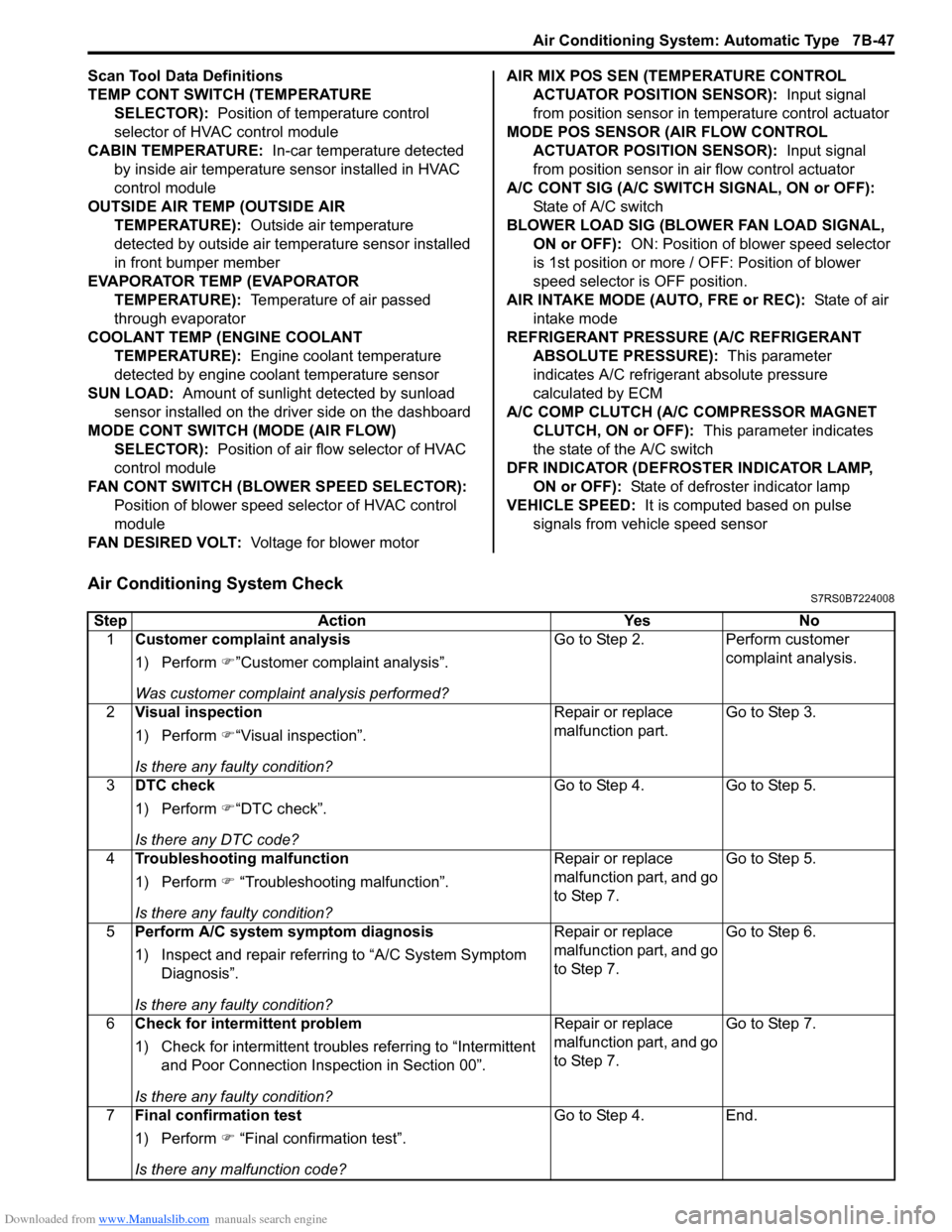
Downloaded from www.Manualslib.com manuals search engine Air Conditioning System: Automatic Type 7B-47
Scan Tool Data Definitions
TEMP CONT SWITCH (TEMPERATURE SELECTOR): Position of temperature control
selector of HVAC control module
CABIN TEMPERATURE: In-car temperature detected
by inside air temperature sensor installed in HVAC
control module
OUTSIDE AIR TEMP (OUTSIDE AIR TEMPERATURE): Outside air temperature
detected by outside air temperature sensor installed
in front bumper member
EVAPORATOR TEMP (EVAPORATOR TEMPERATURE): Temperature of air passed
through evaporator
COOLANT TEMP (ENGINE COOLANT TEMPERATURE): Engine coolant temperature
detected by engine coolant temperature sensor
SUN LOAD: Amount of sunlight detected by sunload
sensor installed on the driver side on the dashboard
MODE CONT SWITCH (MODE (AIR FLOW) SELECTOR): Position of air flow selector of HVAC
control module
FAN CONT SWITCH (BLOWER SPEED SELECTOR): Position of blower speed selector of HVAC control
module
FAN DESIRED VOLT: Voltage for blower motor AIR MIX POS SEN (TEMPERATURE CONTROL
ACTUATOR POSITI ON SENSOR): Input signal
from position sensor in temperature control actuator
MODE POS SENSOR (AIR FLOW CONTROL ACTUATOR POSITI ON SENSOR): Input signal
from position sensor in air flow control actuator
A/C CONT SIG (A/C SWITCH SIGNAL, ON or OFF): State of A/C switch
BLOWER LOAD SIG (BLO WER FAN LOAD SIGNAL,
ON or OFF): ON: Position of blower speed selector
is 1st position or more / OFF: Position of blower
speed selector is OFF position.
AIR INTAKE MODE (AUTO, FRE or REC): State of air
intake mode
REFRIGERANT PRESSURE (A/C REFRIGERANT ABSOLUTE PRESSURE): This parameter
indicates A/C refrigerant absolute pressure
calculated by ECM
A/C COMP CLUTCH (A/C COMPRESSOR MAGNET CLUTCH, ON or OFF): This parameter indicates
the state of the A/C switch
DFR INDICATOR (DEFROSTER INDICATOR LAMP, ON or OFF): State of defroster indicator lamp
VEHICLE SPEED: It is computed based on pulse
signals from vehicle speed sensor
Air Conditioning System CheckS7RS0B7224008
Step Action YesNo
1 Customer complaint analysis
1) Perform �)тАЭCustomer complaint analysisтАЭ.
Was customer complaint analysis performed? Go to Step 2.
Perform customer
complaint analysis.
2 Visual inspection
1) Perform �)тАЬVisual inspectionтАЭ.
Is there any faulty condition? Repair or replace
malfunction part.
Go to Step 3.
3 DTC check
1) Perform �)тАЬDTC checkтАЭ.
Is there any DTC code? Go to Step 4.
Go to Step 5.
4 Troubleshooting malfunction
1) Perform �) тАЬTroubleshooting malfunctionтАЭ.
Is there any faulty condition? Repair or replace
malfunction part, and go
to Step 7.
Go to Step 5.
5 Perform A/C system symptom diagnosis
1) Inspect and repair referri ng to тАЬA/C System Symptom
DiagnosisтАЭ.
Is there any faulty condition? Repair or replace
malfunction part, and go
to Step 7.
Go to Step 6.
6 Check for intermittent problem
1) Check for intermittent troubles referring to тАЬIntermittent
and Poor Connection Inspection in Section 00тАЭ.
Is there any faulty condition? Repair or replace
malfunction part, and go
to Step 7.
Go to Step 7.
7 Final confirmation test
1) Perform �) тАЬFinal confirmation testтАЭ.
Is there any malfunction code? Go to Step 4.
End.
Page 997 of 1496
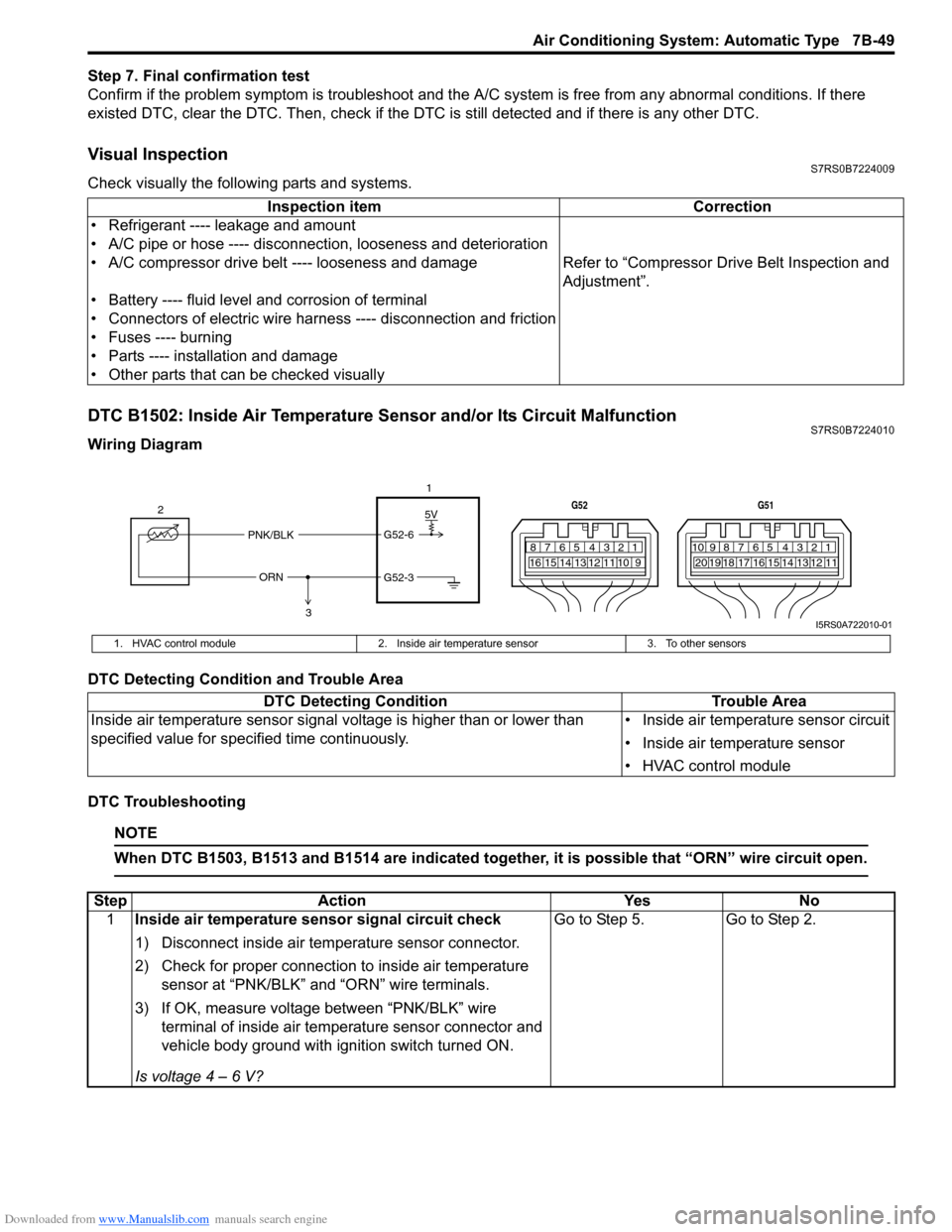
Downloaded from www.Manualslib.com manuals search engine Air Conditioning System: Automatic Type 7B-49
Step 7. Final confirmation test
Confirm if the problem symptom is troubleshoot and the A/C system is free from any abnormal conditions. If there
existed DTC, clear the DTC. Then , check if the DTC is still detected and if there is any other DTC.
Visual InspectionS7RS0B7224009
Check visually the following parts and systems.
DTC B1502: Inside Air Temperature Sensor and/or Its Circuit MalfunctionS7RS0B7224010
Wiring Diagram
DTC Detecting Condition and Trouble Area
DTC Troubleshooting
NOTE
When DTC B1503, B1513 and B1514 are indicated together, it is possible that тАЬORNтАЭ wire circuit open.
Inspection item Correction
тАв Refrigerant ---- leakage and amount
тАв A/C pipe or hose ---- disconnection, looseness and deterioration
тАв A/C compressor drive belt ---- looseness and damage Refer to тАЬCompressor Drive Belt Inspection and
AdjustmentтАЭ.
тАв Battery ---- fluid level and corrosion of terminal
тАв Connectors of electric wire harn ess ---- disconnection and friction
тАв Fuses ---- burning
тАв Parts ---- installation and damage
тАв Other parts that can be checked visually
5V
PNK/BLK
ORN G52-6
G52-3
2
1
3
7812910
65 431516 14 13 12 11
G52
789101920121112
65 431718 16 15 14 13
G51
I5RS0A722010-01
1. HVAC control module
2. Inside air temperature sensor 3. To other sensors
DTC Detecting Condition Trouble Area
Inside air temperature sensor signal voltage is higher than or lower than
specified value for specified time continuously. тАв Inside air temperature sensor circuit
тАв Inside air temperature sensor
тАв HVAC control module
Step
Action YesNo
1 Inside air temperature sensor signal circuit check
1) Disconnect inside air temperature sensor connector.
2) Check for proper connection to inside air temperature
sensor at тАЬPNK/BLKтАЭ and тАЬORNтАЭ wire terminals.
3) If OK, measure voltage between тАЬPNK/BLKтАЭ wire terminal of inside air temp erature sensor connector and
vehicle body ground with ignition switch turned ON.
Is voltage 4 тАУ 6 V? Go to Step 5.
Go to Step 2.